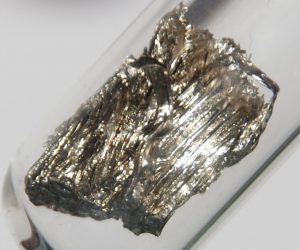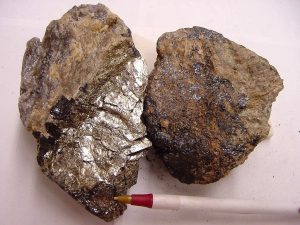Samarium
What is Samarium?
Samarium is a rare earth element of the lanthanide series, which are elements with atomic numbers from 57 to 71. It is a hard silvery metal. It has numerous applications in magnets, industrial chemical processes, cancer radiotherapy, and nuclear reactors.
Samarium’s Place in the Periodic Table
Samarium is a lanthanide. Lanthanides, scandium and yttrium make a group of elements known as the rare earth elements. Even though their name suggests that they are rare, they can be relatively abundant. The reason that they are called rare is because they are difficult to isolate. Rare earth elements are often found together in the same mineral deposits. They can be more difficult to isolate from one another by methods of chemical extraction because they react similarly to the chemical processes required to purify elements from mineral deposits.
- Atomic number: 62
- Atomic Radius: 180 picometers
- Atomic mass: 150.36
- Symbol: Sm
- Group: N/A (Lanthanide)
- Period: 6
- Number of Protons: 62
- Number of Electrons: 62
- Number of Neutrons: ~88
- Number of Isotopes: 7 natural isotopes
Properties of Samarium
Pure samarium is a hard silvery metal that oxidizes slowly in air. At room temperature, samarium is paramagnetic. That means that it is attracted by magnetic fields. In fact, magnets that contain samarium hold their magnetism longer than most other types. Samarium is slightly toxic but present in humans at small amounts. Samarium is used in superconductors that contain carbon or iron compounds. Superconductors are materials that have almost no electrical resistance, and so are the most efficient at conducting electricity.
Physical Properties
Samarium is solid at room temperature. It melts at 1072°C, which is around the temperature of magma. It vaporizes at 1900°C. That is close to the boiling point of lead and the temperature of the ceramic tiles that are used on the bottom of space shuttles when they re-enter the atmosphere at 4.6 miles per second.
- Melting Point: 1072°C.
- Boiling Point: 1900°C.
- Density of Solid Samarium: 7.52 g cm-3.
- Phase at Room Temperature: solid
Chemical Properties

- Oxidation states: +1, +2, +3, +4, +5
- Specific Heat: 196 J kg-1K-1
- Electronegativity: 1.17 (Pauling scale)
- Heat of Fusion: 62 kj mol-1
- Heat of Vaporization: 192 kj mol-1
- Electron Configuration: [Xe] 4f66s2
Isotopes
Samarium has four stable isotopes: Samarium-144, samariuim-150, samarium-152, and samarium-154. More than a quarter of samarium is composed of samarium-152. There are three long-lived radioactive isotopes (samarium-147, -148, -149), which have half-lives in the range of hundreds of billions of years. Samarium-151 has a half-life of 90 years, and samarium-145 has a half-life of 340 days. Several other short-lived radioactive isotopes of samarium have been detected in laboratories with half-lives on the order of minutes to seconds.
Alloys and Allotropes
Samarium is primarily used in combination with cobalt to make magnets. They are generally composed of 1 part samarium to 5 parts cobalt. These magnets are easily broken or chipped, so have no mechanical uses.
Compounds of Samarium
Samarium (III) oxide is added to glass to absorb infrared light. Samarium oxide is used as a catalyst to dehydrate (i.e. remove water) ethanol. Ethanol is hydroscopic, meaning that it absorbs water from the atmosphere. It is very costly to remove all of the water from ethanol. Therefore, most laboratories use 95% ethanol instead 100% ethanol because it is much cheaper. Misch metal is a metal used to create sparks for lighters. Samarium makes up 1% of misch metal, and is responsible for the spark.
Interesting Facts about Samarium
- Paul-Émile Lecoq de Boisbaudran also discovered gallium, gadolinium and dysprosium.
- Samarium cobalt is used to transmit vibrations from guitar strings in the form of electrical signals for electric guitars.
- Samarium was used to make the first X-ray laser.
- The electrical conductivity of samarium is sensitive to pressure, so it can be used as a pressure sensor in electronics.
Occurrence and Abundance of Samarium
Samarium is more abundant on Earth than it is in the universe as a whole. While 5 x 10-7 % of the universe is made up of samarium, it is over 1000-times more abundant on Earth. China, the United States and India have the largest sources of samarium. It is present in a variety of minerals including monazite, bastnasite, cerite, gadolinite, and samarskite (see picture). These minerals contain other rare earth metals like cerium, lanthanum, neodymium, and yttrium. Samarium can be found in the liver and kidneys but its role in human biology is not well known.
Uses of Samarium
Most Notable Uses in General
The magnetic properties of samarium have made it useful for applications in small motors, headphones, and musical instruments.
Most Notable Uses in Science
Samarium is often used as a catalyst in chemical reactions during the industrial purification of chemicals. It can be used as a catalyst for chemical reactions that decompose plastic and remove pollutants.Radioactive samarium-153 is used by doctors to treat lung, prostate, breast, and bone cancer. Samarium is also used by physicists at nuclear power plants. Radioactive decay results in the release (or radiation) of sub-atomic particles, such as neutrons. This type of radiation is dangerous because it can destroy complex chemicals, like DNA, in our body. Samarium is used to capture neutrons released from nuclear reactors.
Discovery of Samarium
Samarium was discovered by Paul-Émile Lecoq de Boisbaudran, a French chemist, in 1879. Samarium was named after the mineral samarskite, and samarskite was named after a Russian official in charge mines. His name was Colonel Vasili Samarsky-Bykhovets.
Samarium in the Future
New x-ray technologies are being developed using samarium. Compounds of samarium, barium, fluorine, and chlorine act as phosphors. Electromagnetic radiation is composed of photons with different levels of energy. Radio waves, for example, have low energy, visible light has intermediate energy, and x-rays have high energy. When photons strike the surface of a material, they can be absorbed or reflected. Phosphors absorb photons of a high energy and release photons of a lower energy. Samarium phosphors have been found to absorb x-rays and produce visible light. By producing visible light, samarium phosphors can be used to view x-rays in real-time. The phosphors are reusable and so are better than photographic film, which can only be used once.

